Your Feature is Not a Product
The classic mistake we keep making over and over again -- and why too many in Generative AI companies (and investors) are repeating it today
TL;DR
One common pattern in every new technology adoption cycle is that features enabled by new technology gets confused for stand alone products. In particular, the technological innovation itself- which is often just a feature - gets confused for a product.
Both experts and novices alike do this and it generally leads to a lot of false starts and “products” introduced to the market that are incomplete solutions. These “products” subsequently fail to reach liftoff after launch, because they don’t completely solve a customer’s problem completely or don’t add enough value for them to pay them for it. This is particularly easy to do with software products but which can be deployed to market much more readily (post to an app store or web site) than physical products that must be produced, stored and shipped to customers, which leads to a certain degree of “measure twice, cut once”.
Confusing a technology or feature for a product is an example of Maslow’s Hammer: “if you have a hammer, everything suddenly looks like a nail.” It’s a very common trap for engineers because we often bias towards thinking about the potential of a new technology without thinking about how it will be introduced and conveyed to customers as a product (I have made this mistake myself before in spades and know it well).
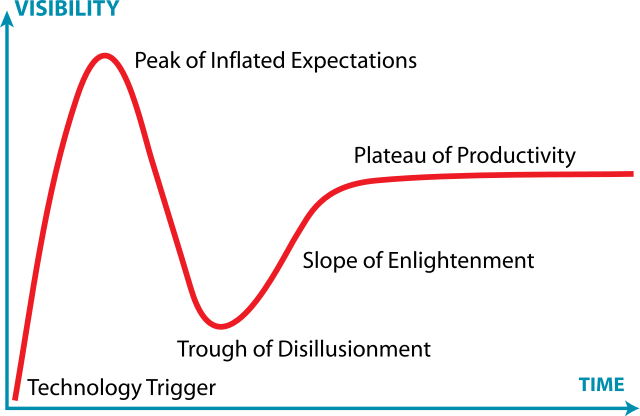
This is a particularly easy trap to fall into with new technologies at the beginning of a Gartner hype cycle (see Figure 1) where the focus is on “the next new thing” and pressure is there to beat others to market quickly. Focus goes to the tech rather than the scaffolding of user experience, solutioneering, systems engineering and the sales & marketing scaffolding and ecosystem to sell & ship it the product to new customers. A feature trying to be a product gets beaten by an older, established product lacking the new features but with great user experience and distribution almost all of the time, so understanding when you are trying to launch an incomplete product in time to fix it can save your company from disaster.
A feature trying to be a product gets beaten by an older, established product with known user experience and distribution, almost all of the time
Let’s look at how this applies to the “latest new thing”. I’ll start with some definitions and then some examples that are meant to enlighten rather than provide an exhaustive list. Finally I’ll talk about how Generative AI companies are falling into this trap a lot these days.
What makes a feature? What makes a product?
Without diving too much into a systems architecture lecture, lets try to define our terms as loosely as possible.
A feature is the smallest element or component of a system that solves a specific job. Specific features convey a specific benefit to the user. For instance, spellcheck is a feature in a word processor when benefits the user by reducing the number of spelling errors they make in their final product.
A product on the other hand, is a superset of features which provides a stand-alone solution to a particular user’s needs. The needs can be functionally decomposed into requirements which map to the features of the product. A product is best thought of as something which for a particular end user satisfies their needs satisfactorily enough to merit them adopting it and (ideally) paying you for it. Spellcheck is a Feature in a Word processor (or any other text based tool for that matter). People may be willing to pay more to add a feature for a particular product, but the feature lacks totality as a standalone thing.
This classification is best understood by example or qualitatively so the table authored by Richard Mironov provides a great set of tests. Great systems architects and product managers have an intuition for this.
Infamous Past Examples of what was thought to be a Product but turned out to just be a feature after all
This category of failed “half products” fall into a couple different buckets:
It’s a product, but users don’t want to pay for it by itself (too thin a slice of value stack)
This first category is comprised of products that could potentially stand on their own, but lack independent distribution channels or lack completeness, which prevents them from really gaining traction/monetizing. They are too a thin slice of the value stack in a particular vertical and are dependent upon other companies (potential competitors) to get their product out there. Like a remora, they draft off of a larger player product or platforms, until the largest company notices and…you’re lunch.

The most obvious historical example of this is Netscape’s Navigator browser. While it was leaps and bounds ahead of Internet Explorer (IE) from a user experience perspective (the joke at the time was that IE was so terrible that it was really only useful to… download Netscape), it ultimately failed because Microsoft was able to distribute its own crappy browser with the rest of the software suite and basically price Netscape out of the market (by making it effectively free). Much of this had to do with the fact that Microsoft owned the land (the base software, ie Windows and the Office bundle) that was initially shipped with virtually every PC on the market, whereas Netflix had to rely on being downloaded later. To quote Mel Brooks: “It’s good to be king!”.
Over time, Microsoft improved the browsing experience just enough that people would tolerate IE’s shortcomings. Then consumers reluctance to pay for an objectively better product when they were getting a slightly inferior one for free kicked in, and Netscape was history. Nowadays I can’t think of anyone who pays for a browser - Safari, IE, Chrome and Mozilla Firefox are all basically freeware. Lacking a compelling independent reason for someone to pay for you as a stand-alone project ultimately turns you into a feature in someone else’s product, rather than a stand-alone product yourself
Lacking a compelling independent reason for someone to pay for you as a stand-alone project ultimately turns you into a feature in someone else’s product.
It’s a product that is entirely coupled to (and at the mercy) of it’s distribution platform
This is a very common problem for many B2C companies. Early Paypal (circa 2000-2002), narrowly avoided ending up in this category. 80%+ of it’s revenue was coming from one platform, eBay, and eBay had made the decision to develop their own payment platform in house. Their solution? Sell to eBay. Eventually they improved the feature set and were able to stand on their own as a payment product, at which point eBay spun them out again.
Farmville and other Zynga games found themselves similarly at the mercy of Facebook in 2010-2012 when Facebook sought to choke their revenue sources through a crackdown on malicious banner ads and when many users complained were annoying notifications (“Thank you for helping me build my farm”…Oy!) cluttering up their feeds.
Zynga eventually developed its own Farmville app for the iPad and iPhone and controlled their own destiny, at least until Adobe’s decision to sunset the Flash language in 2020.
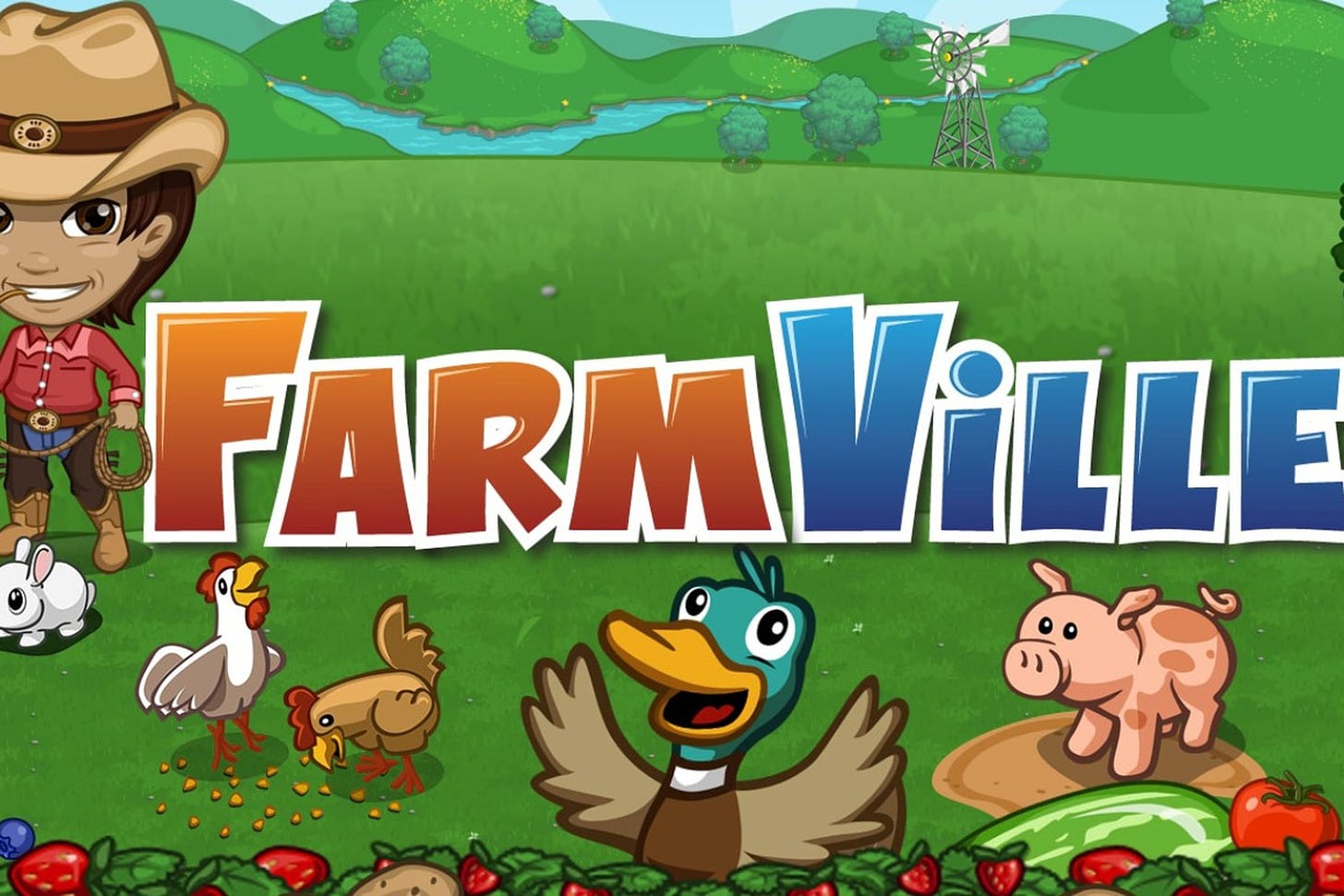
It’s obviously a feature trying to be a product
Anyone else remember the Bump app? Or the Flashlight app that would turn your whole screen white so you could use it as a flashlight? Yeah, these things still exist, you just get them for free built in components to your phone (your flashlight and Airdrop).
Rube Goldberg and Feature Creep
One of the hazards of letting engineers work uncoupled from economics and a product team focused on the user experience is feature creep. This frequently happens without robust baseline management, thoughtful systems engineering, and a focus on fielding the minimal product to solve just the customer’s needs…and nothing more.
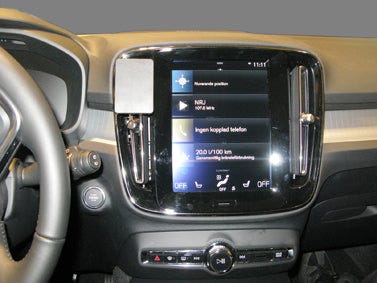
A prime example of this (and an extremely relevant example for me) is the infotainment system on many new cars, which are so overfilled with new features that they actually amplify the driver distraction many of these same features are intended to minimize. Ever try to get your podcasts to play while your phone is charging in the wrong outlet in your car? Good luck, and even worse some new cars will even override your backup camera while you’re doing it. This is a classic example of how a collection of features thrown together with minimal consideration for user experience creates an awful product.
Chindogu: the product creates negative externalities that offset any benefit from it’s features
The Japanese have a word for the most flagrant examples of these: “Chindogu”: an ideal solution to a particular problem, that may cause more problems than it solves. While some silly examples like the “toilet paper roll hat” and “umbrellas for your shoes” come to mind, in the hardware domain this is actually a thing that happens more often than you think.
Perhaps the best example I can think of for this is the Davy Crockett: a recoilless rocket launched tactical nuclear weapon insanely deployed by the hundreds during the 50s and 60s to help stave off thousands of Russian tanks anticipated to come pouring through the Fulda Gap in Germany. The rifle had a range of 1.25-2.5 miles, which even with a .05 kiloton micronuke, is a little too close for comfort for something with a 180 meter 100% kill radius. It was also evaluated as “shockingly inaccurate”. Sounds like a great idea!
Generative AI and the product/feature fallacy
Now that we’ve given some examples of products that were really features (some of which were really impossible to know without a thorough go-to-market sales stroke) let’s talk to the “next new thing”.
Unfortunately, a large number of companies in the current AI wave fall into the trap of thinking that sprinkling the “magic pixie dust” of AGI on an otherwise undefendable product or business model somehow magically makes them a good product. Blindly throwing a technology at a problem without understanding its risks can lead your product to have crappy performance in unintended ways, former DARPA director Arati Prabhakar cautions about that here:
Others still will take the approach of “I can use generative AI to do this” without clearly thinking through why its truly the right hammer to nail the problem or how they can differentiate themselves from five other companies trying to do the exact same surface level thing. As one AI founder succinctly cautioned in FT’s Sifter Magazine (great piece at the link from March of 23): “Many of these companies will fail because they are now jumping onto this hype but essentially they will struggle to find a real problem to solve.”
“Many of these companies will fail because they are now jumping onto this hype but essentially they will struggle to find a real problem to solve.” -Julian Senoner, cofounder of EthonAI
This should trigger Deja vu because it wasn’t that long ago, a different set of folks was adding “blockchain” and “metaverse” on whatever hairbrained ideas they were trying to make catch fire to try and ride the wave of “the next new thing”. Anyone remember “Roomba on the blockchain” or buying property in the metaverse?
There is a whole category of founders that are like category nomads and are constantly chasing the next new thing in the hopes of surfing the left hand side of the Gartner curve to a near term payday. According to Zac Bogue of DCVC in a recent forum from Davos, this has become so common in their diligence they have an acronym for it: “FICTA: Failed in Crypto, Trying AI.” (he talks about it at minute 39 of the video in the link).
AI Wrapper companies completely fall into this category in the sense that the only value they really add is a wrapper around an LLM to try and make it more usable, but in and of themselves don’t represent an independent product. They lack a walled garden of data or curation that allows them to mitigate hallucinations or switched to different toolsets where appropriate (e.g. a simple calculator where math is involved since LLMs often have problems with math). They are effectively white labelling someone else’s LLM with little value add beyond that. That makes them a feature, not a product.
Customers don’t care what’s under the hood - they just care about it solving their problem
This brings me to a key point I’ve seen over and over again in systems architecture and product design.
One of the first lessons I learned about requirements development as a young systems engineer was the principal of “magical moon rocks”: write your requirements as if the solution is being solved by magical moon rocks. That is, make it as agnostic to the means of how you intend to solve the problem as possible. Don’t get enamored with specific feature sets or technologies, but rather focus on the what it is you are trying to do
As Neumann in Figure 10 below points out, the average user cares more about the results than the technology used to produce them. If you can solve the user’s problem without LLMs or Generative AI, it will still sell if it has a better user experience, is easy to try and buy and solves their problem more readily. Don’t assume it has to include a certain technology to win.
Conclusion and Advice from the GOAT of Product Design
Steve Jobs was arguably the greatest product architect of his generation if not the modern era. The smartphone that he conceived has literally reshaped the human mind its impact is so great. He didn’t suffer fools and he also didn’t put the cart before the horse. He absolutely nails it in the clip below:
"You've got to start with the customer experience, and work back to the technology. Not start with ‘Lets's sit down with the engineers and figure out what awesome technology we have and how are we going to market that.’" - Steve Jobs
So let’s all stay clear headed and focus on how technology enables great products rather than getting enamored with the next great thing and putting the cart before the horse.
Special thanks to Liz Stein and Rob L’Heureux for helping me brainstorm some of the features masquerading as products for this piece.




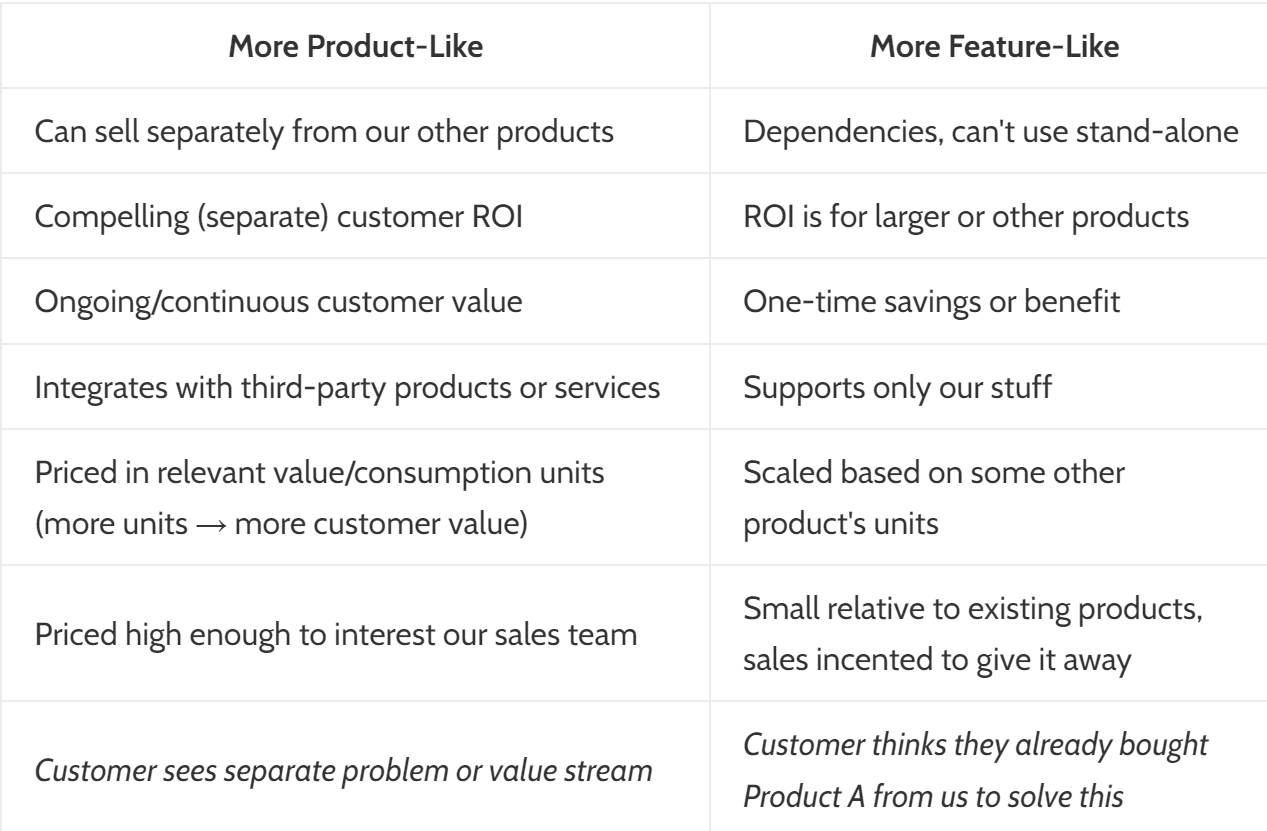

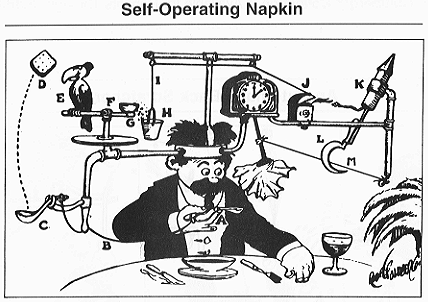


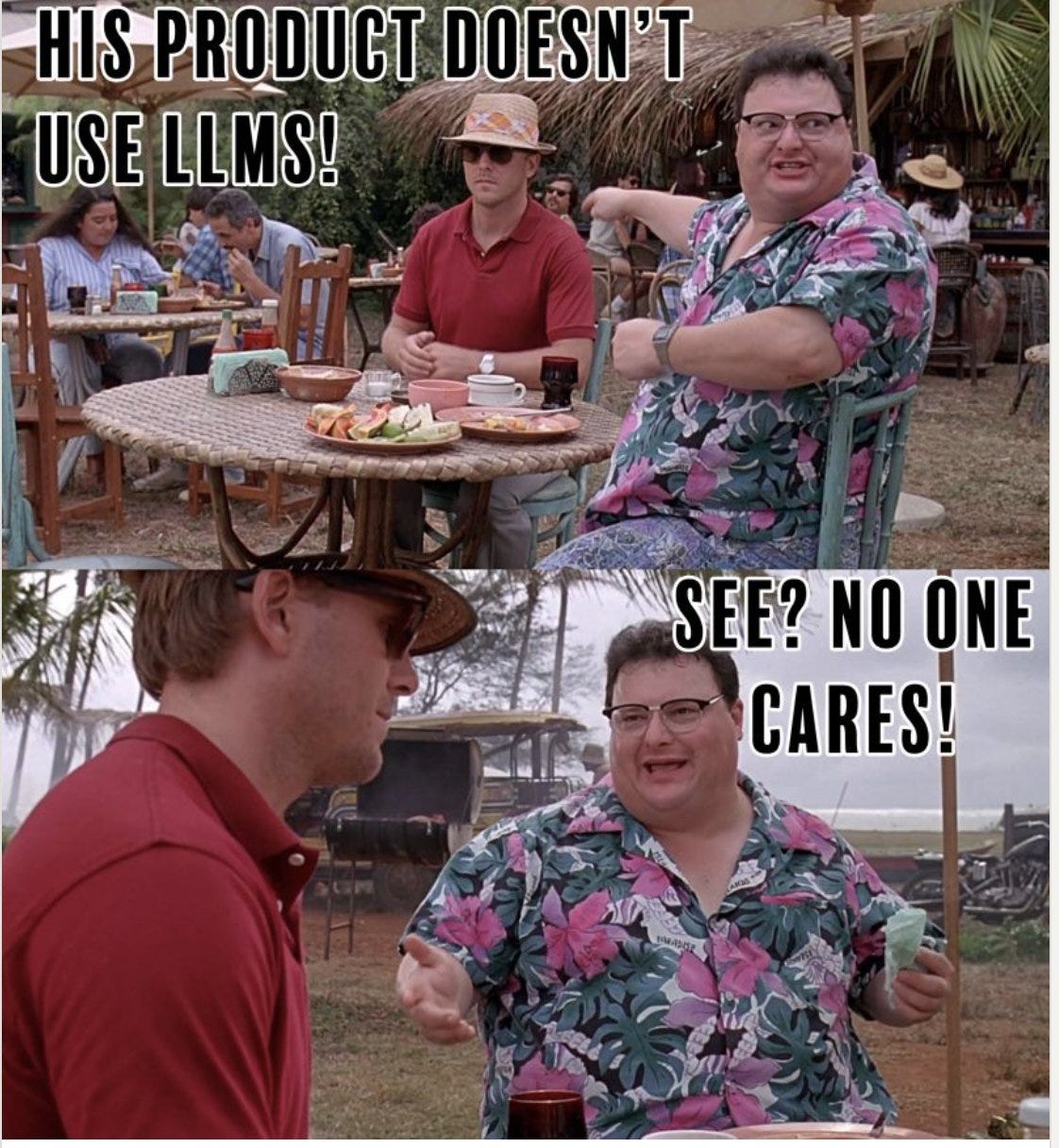
Great post. On the topic of generative AI/LLM wrappers, I think the problem is even more stark than what you propose. LLMs are quickly becoming commoditized tech (token costs across LLMs are nearly at parity). The market isn't really differentiating between OpenAI, Gemini, etc. Building a feature and not a product is risky enough. Doing so on top of commoditized tech is even more so.